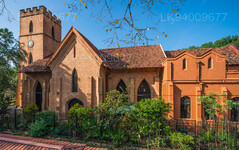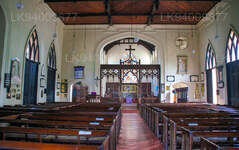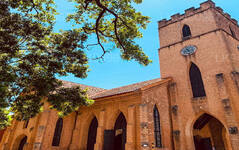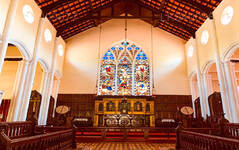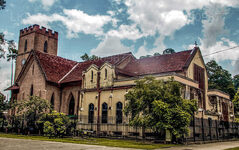
Kandy City
Kandy, en malerisk by i det centrale Sri Lanka, er kendt for sin rige kulturarv, livlige festivaler og smukke natur. Beliggende midt i frodige bakker, er den hjemsted for Tandtemplet, der er på UNESCOs verdensarvsliste, og byder på en betagende blanding af historie og naturlig pragt.
St Pauls Church
St Paul’s Church is an Anglican Church located in an area called Milagiriya in Colombo 04, Sri Lanka. It has its origins in the Portuguese era of the 16th century. Today it is one of the oldest and most historic churches within Colombo and is also well known due to the attached girls’ school. Here’s the story of how it came to be:
The Early Portuguese Church
Over four centuries ago, when the Portuguese invaded Sri Lanka – they caused mass destruction to the local religions and built Roman Catholic Churches to spread their discipline of Christianity. It is unknown why they chose to build a church at that specific location, but perhaps there may have been some sort of locally popular shrine there that they destroyed and built over – as was their habit.
The newly built church, at the time, was known as ‘Nossa Senhora dos Milagres’ or ‘Our Lady of Miracles’. The locals, due to their lack of knowledge and understanding about the Portuguese language, took to calling the church ‘Milagres’, which is actuality meant ‘Miracles’. With time the name evolved, and the entire area surrounding the church came to be known as ‘Milagiriya’.
The British Takeover
However, the ‘Church of Miracles’ did not last. Approximately a century later, Ceylon was invaded by the Dutch who suppressed the Portuguese and wrested control of the valuable trade route island from them. To consolidate their rule, the Dutch thoroughly destroyed all Portuguese monuments and churches that they could find. Nossa Senhora dos Milagres was one of these churches that fell under their hands. The consecrated land remained bare for over a century, until the British decided to invade and took control of Sri Lanka from the Dutch.
The Building of St Paul’s
In the 1840s, a large number of Anglican churches started to get constructed. The premise behind them was mainly to give places of worship for British countrymen, but also to persuade the native population to change their religion and follow the Anglican discipline.
St Paul’s Anglican Church, which was built over the ruins of the old Portuguese church in Milagiriya, was one such church built by the British. The construction of the church began in 1948 under the initiation of the British cleric, Reverend Joseph Thurston, who dedicated it to St Paul. It was completed in 1953 and consecrated by the Bishop of Colombo at the time. An attached industrial school was also built at the same time to give a place of learning for Anglican youth. However, the main attraction was the font within the church grounds, hailing from the time of the previous Portuguese church. Its water was said to have miraculous healing properties, and sick people from all over the country visited the church to experience this healing.
Between the 1890s to the early 1900s, the church flourished and many locals joined the congregation as well. This was also partly due to the efforts of the first two vicars, Rev. John Ford and Rev. Harry Marsh ,who worked within the neighborhood to help the natives at their times of need.
A Change in Leadership
In the early 1900s, with the arrival of the First World War, the British began losing interest in Sri Lanka. Many Englishmen and other Europeans left the island, returning to their home countries or moving to the newly settled land of Australia. The leadership of St Paul’s fell into the hands of the elite and influential members of the congregation, and the very first native Sri Lankan Vicar for the church was elected in 1920. Rev. Paul Lucien Jansz took up official duties as the third vicar of St. Paul’s, and continued till 1953.
In the meantime, the Second World War occurred in the 1940s and the British lost much of their troops. It spelled the death knell to Britian’s supremacy over the countries in the East and Far East. They gave independence to most of those countries that they had established a rule over, and returned back to England or went to Australia. By the 1950s and 1960, when Rev Jansz ended his term as the vicar of St Paul’s, there were little to no British clergy left to take over the office and the vicarage continued to be passed over to Sri Lankans – fulling transferring the leadership to native hands.
The Church as it is Today
Today St. Paul’s Church in Milagiriya comes under the Church of Ceylon, the main Anglican Church in Sri Lanka, and is part of the diocese of the Archbishop of Canterbury. The vicars throughout the years continued to grow and develop the church, making it extremely popular amongst the Colombo population. Today the congregation consists of a large mixed crowd of individuals: Sinhalese, Tamils, Burghers, and Europeans who stay in Sri Lanka for longer periods.
The church itself resembles a Greek Basilica. Five services occur on Sunday in the church’s chapel in the left wing, named ‘Chapel of our Lady’, where the original 19th century altar still remains. The miraculous font is still popular and visited by many church goers. The attached school that once was a place of industrial learning, was converted into a government managed learning institution for girls and became known as St. Paul’s Girls School, Milagiriya. The most recent renovations to the church added a service center for children and adults.
St Paul’s often community activities for disadvantaged children. They run a home for disabled children in the region of Mayura Place in Havelock Town. There is also a project done by the church that benefits children from the slums near the stations of Colombo 4 and Colombo 6.
The church also maintains links to congregation members who migrate abroad and churches from other countries. This provides them a global perspective that which they then implement among the local community.
Today any visitor is warmly welcomed by the vicar and/or clergy, and can take part in the services and community activities of the church if they wish to. The vicar is also quite happy to give further insights to the history of the church and point out places of interest within the church grounds. So it’s definitely a peaceful and interesting place to go to if you’re in Colombo.
Om Kandy-distriktet
Kandy-distriktet ligger i den centrale provins i Sri Lanka. Kandy er et af Sri Lankas syv verdensarvssteder og var engang hjemsted for Kandy-kongerne i det 16. århundrede og en kilde til al musik, kunst, håndværk og kultur i landet. Omkring 129 km fra Colombo ligger Kandy i et bakket terræn, og alles øjne drages mod byens centrum, hvor Kandy-søen danner et charmerende element. Kandy har fortsat stor religiøs betydning for Sri Lanka, fordi det er i denne charmerende by, at Dalada Maligawa eller "Tandtemplet" ligger, hvor Buddhas hellige tandrelikvie ligger velbevogtet.
Den Kongelige Botaniske Have i Peradeniya ligger omkring 5 km vest for bymidten i Peradeniya og besøges af 1,2 millioner mennesker om året. Det er den største botaniske have på øen. Udawatta Kele (Udawatta-skoven) er et beskyttet reservat beliggende i hjertet af byen, lige nord for Tandtemplet.
Kandy er en by med et flertal af singalesere; der er betydelige samfund, der tilhører andre etniske grupper, såsom maurere og tamiler. Kandy er kun overgået af Colombo, centrum for Sri Lankas økonomi. Mange store kooperativer har store filialer i Kandy, og mange industrier, herunder tekstiler, møbler, informationsteknologi og smykker, findes her. Mange landbrugsforskningscentre er placeret i byen.
Og et springvand for al musik, kunst, kunsthåndværk og kultur i landet. Omkring 129 km fra Colombo ligger Kandy i et bakket terræn, og alles øjne drages mod byens centrum, hvor Kandy-søen danner et charmerende træk. Kandy har fortsat stor religiøs betydning for Sri Lanka, fordi det er i denne charmerende by, at Dalada Maligawa eller Tandtemplet ligger, hvor Buddhas hellige tandrelikvie ligger velbevaret.
Om Centralprovinsen
Den centrale provins i Sri Lanka består primært af bjergrigt terræn. Provinsen har et areal på 5.674 km² og en befolkning på 2.421.148. Nogle større byer inkluderer Kandy, Gampola (24.730), Nuwara Eliya og Bandarawela. Befolkningen er en blanding af singalesere, tamiler og maurere.
Både bjerghovedstaden Kandy og byen Nuwara Eliya ligger i Centralprovinsen, såvel som Sri Pada. Provinsen producerer en stor del af den berømte Ceylon-te, som blev plantet af briterne i 1860'erne, efter at en ødelæggende sygdom havde dræbt alle kaffeplantagerne i provinsen. Centralprovinsen tiltrækker mange turister med bjergbyer som Kandy, Gampola, Hatton og Nuwara Eliya. Tempeltand eller Dalada maligawa er det vigtigste hellige sted i Centrel-provinsen.
Klimaet er køligt, og mange områder omkring 1500 meter har ofte kølige nætter. De vestlige skråninger er meget våde, nogle steder med næsten 7000 mm regn om året. De østlige skråninger er dele af den midterste tørre zone, da den kun modtager regn fra den nordøstlige monsun. Temperaturerne varierer fra 24°C i Kandy til kun 16°C i Nuwara Eliya, som ligger 1.889 m over havets overflade. De højeste bjerge i Sri Lanka ligger i Centralprovinsen. Terrænet er for det meste bjergrigt med dybe dale, der skærer sig ind i det. De to vigtigste bjergregioner er det centrale massiv og Knuckles-bjergkæden øst for Kandy.

